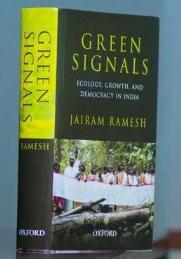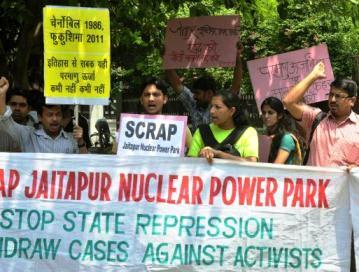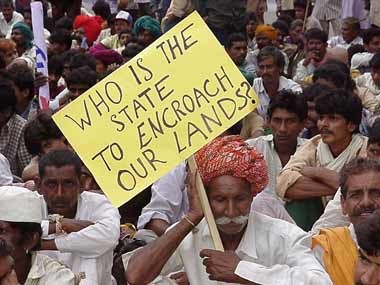On a pleasant March day (the last of the year’s pleasant March days in Delhi) at his Lutyens’ bungalow, former environment and forests minister Jairam Ramesh discussed with Padma and Ranjan the thought processes that shaped Green Signals: Ecology, Growth, and Democracy in India, his recently released book which he believes is a must-read for climate-change stakeholders – which is all of us, more or less.
Ramesh’s assertive stand on environment protection and decisions as a minister had pitted him against the country’s large business houses as well as his ministerial colleagues. In this informal conversation, he reasons why environmental concerns have to be embedded in the growth process, laments the industry’s mindset on the whole, calls the current government’s attitude dangerous, and explains why it is about choices and solutions”whether in the long or the short run.
Here are some excerpts from the talk:
- Principal points in Green Signals
‘The idea was to bring together a written record of the twenty-five months when I was minister of environment and forests. That was the period when many issues that were at the interface of growth and the environment came into public focus. Whether it related to infrastructure or coal mining or port development or industrial projects, there were issues that had both the growth dimension as well as an environment dimension. This book is a record of how the decisions were approached, why the decisions that were taken got taken, what were the factors that went into taking those decisions.

‘So, the whole purpose of this book is to present my understanding of how the trade-off between growth and environment can be managed – how the two may be integrated, not at the philosophical level, but at the practical level. Note that the book contains the ministerial record and is not merely a reproduction of the bureaucratic files. In many cases I went beyond bureaucratic advice; in some cases I countered bureaucratic advice, while in others I upheld the bureaucratic counsel. For instance, in the case of climate change, the bureaucracy and I were going in two different directions and here I have explained why this was the case and why India needed to be different.
‘The other point in the book is why environment should matter to India. There is a big school of thought here that believes in the ‘grow now and pay later’ model. So, let’s have 25 years of growth and we’ll worry about the consequences later…In the book I have discussed why India should look at sustainability not as a luxury but as a necessity. The country needs to understand what sustainability means in practice. It is a word that everybody uses and may have different meanings for different people. We need to understand what exactly sustainability means in the context of economic growth. Basically, the background is always economic growth. Given that you need rapid expansion and infrastructure development, how do you factor in the ecological issues? That’s the whole purpose of the book.’
- On complexities of the ‘economic growth versus environment sustainability’ debate
‘Environmental concerns have to be embedded in the growth process. There are two ways of looking at it. First, like I said, there’s a whole school of thought that says let’s grow the economic infrastructure and we can handle the environmental consequences later; the other thought says let’s not do anything as there can be too many negative consequences. We have to avoid both the extremes. However, when you are going through the middle path, there is no easy formula because we have to make some trade-offs. For example, you need an international airport for Mumbai, but should that airport be made after destroying hundreds of acres of mangroves? We all know that during the tsunami the only areas that were protected were the ones that had mangroves; the ones without mangroves were devastated.
‘So, should we make an international airport or any other “necessary†infrastructure by diverting rivers, blasting mountains or destroying mangroves? When I was minister, I was not questioning the need for the airport but the particular strategy or the approach or the trajectory behind the whole project.
‘Another case in point is of nuclear clearances. I dealt with the big issue of giving clearances to the Jaitapur nuclear plant.  I did not ask if India needed nuclear energy. That is a very fundamental question and you have people either for it or against it, and I do not want to get into that debate. However, given the fact that India has made nuclear investment, how best do you maximize environmental protection? Of course, the best way of maximizing that is by not having the nuclear plant. But then, that means not having power… so that’s the type of choice that we end up making.’
I did not ask if India needed nuclear energy. That is a very fundamental question and you have people either for it or against it, and I do not want to get into that debate. However, given the fact that India has made nuclear investment, how best do you maximize environmental protection? Of course, the best way of maximizing that is by not having the nuclear plant. But then, that means not having power… so that’s the type of choice that we end up making.’
- When the environment ministry was completely sidelined
‘Coal mining in particular is troublesome because India needs energy. We do not have much nuclear power. We have hydel power which involves submergence and displacement, while solar and wind will take some time to develop. In the short run we cannot avoid coal-based power plants. And many of our best coal reserves are located in forest areas. What do we do?
‘We did a mapping of ‘go’ and ‘no go’ areas and came to the conclusion that 70 per cent of the areas with nine major coal fields fell in the ‘go’ area – where you could mine but with the necessary environmental safeguards. The remaining 30 per cent fell in the ‘no go’ area. However, this 70″30 ultimately got modified to 90″10 where 90 per cent became ‘go’. I am sure now it will become 95 per cent or something.
‘The point is that I also had to find a solution. I could not be “doctor no” all the time. The solution I gave to the government was this: “Do not tamper with the environmental decision-making process. Let it say yes or let it say no.  If it is a yes, then you have no problem. But if it is a no, then you take the call collectively; after all, government is a collective entity. Make a decision based on all factors and decide if it is a must for us to make this investment. In the process do not ask the environment ministry to give a clearance thappa (stamp).†It was not a clean solution but a jugaad way out. In comparison, what’s happening now is more of blind clearances. There is environment clearance for all projects.’
If it is a yes, then you have no problem. But if it is a no, then you take the call collectively; after all, government is a collective entity. Make a decision based on all factors and decide if it is a must for us to make this investment. In the process do not ask the environment ministry to give a clearance thappa (stamp).†It was not a clean solution but a jugaad way out. In comparison, what’s happening now is more of blind clearances. There is environment clearance for all projects.’
- On tough decision making and solution finding
‘Practically, there are no solutions. As far as environment is concerned, there are only choices that have to be made. Either you say yes to a project or you say no. Once you make a choice, that choice will please one and displease another. If you ask me if there is a rulebook or a simple solution, it is just not possible.
‘It is not just about forests. There are issues of tribals, settling tribal rights. There is a provision that we will divert the forest area if you do the compensatory afforestation. However, this compensatory afforestation is more of a joke. On the one hand you are destroying natural forests that harbour a multispecies biodiversity; on the other hand is compensatory afforestation, which is mere plantation of, say, eucalyptus. You can never substitute the natural forest that has been destroyed.
‘Decision making on such issues is not simple. It is very easy to say yes, like it is happening now; it is far more difficult to apply your mind and say we need to protect the biodiversity. The Mumbai airport is the best example. The airport got through but the community was protected, the mangroves were protected. Yes, the process did take about one-and-a-half years, but that much time is needed to come to a constructive conclusion. Now, if you say that the Chinese will eat you up in the interim years and you want all approvals to be quicker, I certainly do not have an argument for that.’
- On the present scenario
‘I think what we are seeing now is blind obsession with rapid growth. I find it dangerous. I think we need high economic growth and we need to sustain that growth, but we also need to ensure that we are taking care of our natural resources. Otherwise we will end up in a situation similar to that in Delhi, with its air pollution and water pollution levels.
‘Sometimes you may end up compromising and you may say that this is not something that we are comfortable with. Sometimes you may end up redesigning the project and put in some safeguards. For example, there was a power plant coming up in Ratnagiri and we realized that the sulphur content emitted by the plant would destroy the mango groves. So we insisted that the plan must have desulphurizers. It needs more time, it needs more cost, but it is needed.’
- On Indian industry’s attitude
‘I think barring a few exceptions the Indian industry has to learn to comply with the law. We take great thrill in passing laws and then bypassing them. If we have a law then why not implement the law and stick to it? And if going by the law takes time, if it takes a year or two, the industry should be alright with it.
‘There are a few industries where green concerns are getting embedded. However, overall the track record of the Indian industry, be it the private sector or the public sector, has been pathetic. Had the track record of the industry in dealing with environment issues, displacement and rehabilitation issues, and deforestation issues been good, the confidence of the people would have been high. The industry is yet to build that confidence.
‘In places like Jharkhand, Orissa and Chhattisgarh, people do not want to give their land for coal mining because they know they will never get it back. They also know of the damage that coal mining does to local communities. If they had the confidence that their interests were going to be fully protected, it would have been easy to talk to them and resolve the conflict.

‘I recently read a news item mentioning that there were about 300 major conflicts in the country last year related to land acquisition alone. People are not willing to give their land to the government. The reason is that their interests are not being fully protected. The logic for clearances that a section of the industry gives is weird. A renowned industrialist once called me to say “hey, look, I have already invested in a power plant and now I need clearance for coal mining.†Wonder why he did not get the mining clearance in the first place.
‘Environment clearance toh ho jayega, apna aadmi hain sarkaar main, has been the attitude of the Indian industry and this attitude has already done a lot of damage.’ 

